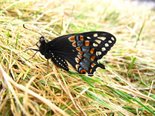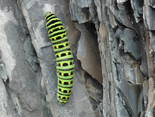
Short-tailed Swallowtail - Papilio brevicauda
Status in Nova Scotia
Very rare. May not be present most years. There is one recent record (2011) in the Maritimes Butterfly Atlas, from Victoria County. The Maritimes Butterfly Atlas S-rank for this species is "S1:Extremely rare: May be especially vulnerable to extirpation (typically 5 or fewer occurrences or very few remaining individuals)".
Flight Period
First two weeks of July. Very few records.
Habitat
Coastal areas, in the presence of the larval foodplant.
Larval Foodplants
Has been found feeding on Scotch Lovage (Ligusticum scothicum) in Nova Scotia. Also reported to feed on Angelica (Angelica atropurpurea) and cow-parsnip (Heracleum spp.).
Similar Species in Nova Scotia
This species is similar to the Black Swallowtail, but has much shorter "tails". It is also very much less likely to be seen here.
Notes
This species is found only in the Atlantic Provinces and eastern Quebec. It is not known whether stable populations exist in Nova Scotia. It may be that this province is occasionally colonized by strays from Newfoundland. It was first reported from Kidston's Island near Baddeck, in 1936.
Further Reading
Very rare. May not be present most years. There is one recent record (2011) in the Maritimes Butterfly Atlas, from Victoria County. The Maritimes Butterfly Atlas S-rank for this species is "S1:Extremely rare: May be especially vulnerable to extirpation (typically 5 or fewer occurrences or very few remaining individuals)".
Flight Period
First two weeks of July. Very few records.
Habitat
Coastal areas, in the presence of the larval foodplant.
Larval Foodplants
Has been found feeding on Scotch Lovage (Ligusticum scothicum) in Nova Scotia. Also reported to feed on Angelica (Angelica atropurpurea) and cow-parsnip (Heracleum spp.).
Similar Species in Nova Scotia
This species is similar to the Black Swallowtail, but has much shorter "tails". It is also very much less likely to be seen here.
Notes
This species is found only in the Atlantic Provinces and eastern Quebec. It is not known whether stable populations exist in Nova Scotia. It may be that this province is occasionally colonized by strays from Newfoundland. It was first reported from Kidston's Island near Baddeck, in 1936.
Further Reading
- eButterfly.org: Nova Scotia records, Canada records
- iNaturalist.org: 3 Nova Scotia records, 470 North America records
- The Butterflies of Canada
|
|



![Short-tailed Swallowtail - Carron Point, NB - 2010-06-18 [Short-tailed Swallowtail image]](img/010161tl.jpg)


